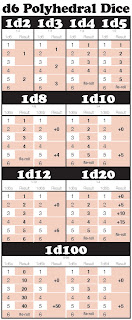I've been making little layout projects for myself, to brush up on InDesign. And I saw this Portcullis post for rolling polyhedral results with d6's. Thus:
I'm not sure that this has much practical value in the
smartphone age, but it would have saved my 12-year-old self a lot of
headaches (I remember spending a lot of time flipping through books to
use page numbers as random generators. Weird how I only ever
rolled odd numbers).
Anyway, this turns out to be a pretty good way to learn about making tables with InDesign.
 |
| Click for a pdf! |
Anyway, this turns out to be a pretty good way to learn about making tables with InDesign.
Comments
Post a Comment